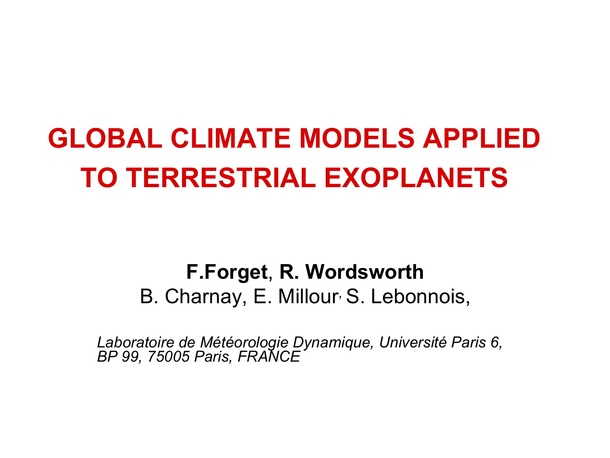Bridging the gap > Franç̧ois Forget

If initial loading stalls, switch to the Flash version.
Global climate models
applied to exoplanets
Franç̧ois Forget
LMD/IPSL, Paris, France
Help



Abstract: The possible climate conditions and habitability of extrasolar terrestrial planets have so far mostly been studied with simple 1D steady-state radiative convective models that simulate the global mean conditions. Much has been learned, but the next step is to perform 3D simulations using Global Climate models (GCMs) similar to those used on Earth for weather forecasts or climate evolution studies. Because these models are almost entirely built from physical equations (rather than empirical ones), they can be applied to many kinds of terrestrial planets. Indeed, a full GCM can be considered as a ‘planet simulator’ that aims to simulate the complete environment on the basis of universal equations only. Our team has developed GCMs for the terrestrial atmospheres in our solar system (Mars, Venus, Titan, Triton, Pluto). These projects have confirmed that many processes controlling the climate (e.g., large-scale dynamics, turbulence,storage and diffusion of heat in the subsurface, etc...) can be modelled using the same equations on most terrestrial planets. On this basis, we have developed a new ‘universal’ GCM, which by construction will be general enough to study a wide range of possible habitability scenarios. The real challenge has been to develop a radiative transfer code fast enough for 3D simulations and versatile enough to model any atmospheric cocktail / thick atmosphere accurately. We will present a study performed to represent the exoplanet Gliese 581d, on the outer edge of the habitable zone, and preliminary results on the behaviour of a planet near the inner edge of the habitable zone, with liquid water on its surface, but exposed to a stellar radiative flux larger than on the Earth.
Additional materials: PDF of slides
ExoClimes 2010, Exeter, Thursday 9th September 2010
Additional materials: PDF of slides
ExoClimes 2010, Exeter, Thursday 9th September 2010
